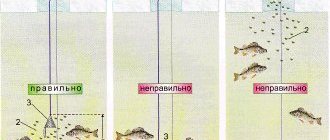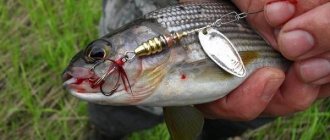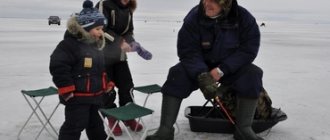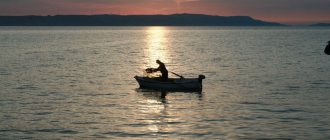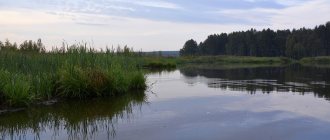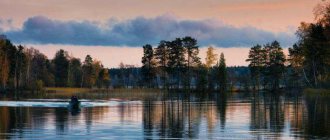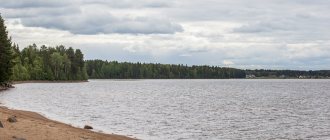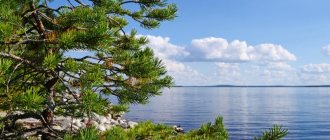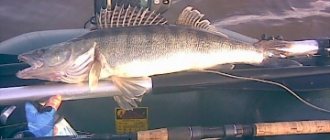Cheboksary Reservoir
The Cheboksary Reservoir is one of the reservoirs of the Volga-Kama cascade, located on the Volga River, in the territories of the Chuvash Republic, the Mari El Republic and the Nizhny Novgorod region.
Formed by the dam of the Cheboksary hydroelectric power station, located in Novocheboksarsk (Chuvash Republic). Filled in 1980-1982. Area 2190 km², length 341 km, greatest width 16 km, depth up to 35 m.
Large bays along the valleys of the Kerzhenets, Sura, and Vetluga rivers. On the banks of the Cheboksary Reservoir are the cities of Nizhny Novgorod, Kozmodemyansk, and Cheboksary.
Fishing Features
Getting to the Cheboksary Reservoir is not difficult. Numerous highways and country roads lead to settlements located along the banks of the reservoir. It is better to go from popular parking areas to quiet backwaters by boat, since wherever there are vehicle access to the river, there are many fishermen, but almost no fish. From Moscow to the Cheboksary Reservoir is a whole night's drive. In this regard, you can stop at one of the fishing and tourist bases or become a tent camp in one of the clearings you like. There are a lot of fish in the reservoir. She's easy to catch. If you have a boat, suitable gear, bait and feeding, you can take medium-sized roach out of the water all day or hunt large perch. Three places on the reservoir are considered the most catchy by amateur fishermen. The first is located near the village of Makarievo. You can get there by car along the road going through the dam from Lyskovo. In the coastal waters of the island located here, predatory fish species gather in large schools for feeding. They are apparently attracted by the abundance of small fish that seek refuge in numerous channels. The second and third are the mouths of Kerzhenets and Sundovik. The place where Sundovik flows into the Volga is preferred by numerous fans of fishing for large bream, as well as channel pike.
Features of the Cheboksary Reservoir
The Cheboksary reservoir is a river-type reservoir, in some places there is a current, and quite strong, in some places there is none, but the reservoir still does not turn into a swamp. Some places are deep, with holes, somewhere the depth is shallower. Somewhere the bottom is more or less clean, somewhere it’s snags (by the way, because of these snags it’s quite difficult to catch with wobblers, but still not impossible). In general, it is better to fish with unhooked baits - this option will minimize the loss of bait. It’s also a good idea to have a good hook; in this case, you can fish with wobblers, poppers, and the like, with a lot of dangling tees that constantly try to catch on something else other than fish.
Promising places for fishing
This is perhaps one of the most interesting and catchable places in the reservoir. It is located near the village of Makaryevo. You can get to the fishing spots in the reservoir along the dam from Lyskovo. From there you can take a boat to the island, where you can fully enjoy very interesting and quite rare fishing. Why interesting? And why is it so rare? For a predator, this place is a real festive table and the predator’s fattening takes place there very vigorously. Fishermen who visited these places cited the same interesting facts. The cauldrons created there by the predator millet are enormous, and after the next cast it is even difficult to predict what kind of prey you will have on the hook: pike, asp, pike perch or perch. This is a real intrigue, this is an unprecedented gluttony of different predators in one place and at one time, a very rare phenomenon. What attracts such a variety of predators to this place? Apparently a large number of small things have found refuge in numerous tributaries and islands.
Fishing on the Cheboksary Reservoir at the mouth of the Kerzhenets is very promising for spinning anglers. This is one of the most catchy points, where in the summer there are large perch boilers and a huge number of pike live. There are a lot of anchored places here and of course there is a lot of bait left here, you can get caught firmly with an anchor, and therefore it is better if a safety rope is attached to it.
Near the Makaryevsky Monastery, which hangs over the water. The islands end, and an excellent and promising stretch for spinning enthusiasts opens up. This is one of the most favorite fishing spots for both local anglers and visitors. Guests from other regions began to often visit these places after the Barmaland floating fishing base appeared here.
The main hunt here is for pike, catching specimens weighing 10-12 kg, this happens quite often here, but mostly pike weighing 4-6 kg are caught and in a morning you can catch about 10 toothy predators.
But there are significantly fewer perch pools here than in the waters of the islands, but near the shore you can catch a lot of medium-sized perch. Perch cauldrons can be identified by the seagulls that circle around them, and even then descend to the water to capture prey. Also, asp is often found in these boilers, so it is especially not recommended to fish here with ultralight. Moreover, the bait is often taken by perch weighing about a kilogram or even more. So, it’s better to have more reliable tackle in your hands.
Fishing in the Cheboksary Reservoir in these places is also promising for pike perch. There are excellent pike perch points here. Some of them can be calculated using an echo sounder, others by landmarks on the shore. They represent 2 ridges stretching from the shore perpendicular to the current. Next to these ridges there are holes that have decent depths, which attracts a large number of fanged animals. There are also a lot of snags here, which requires the use of non-snagging baits. Foam rubber with hooks recessed into it works well here. But it is practical only for catching pike perch or perch; it is of little use for perch; striped fish simply do not have enough strength to push through the bait, but for pike perch it is easy to do. It is better to catch pike perch here in the morning or evening dawn.
Another very promising place that is worth paying attention to is the mouth of the small Sundovik River. This river flows into the Volga from the right side, unlike the Kerzhenets mouth, which is located on the left bank.
In this place, the Volga with its tributaries forms a wedge-shaped peninsula. In these places you can catch both “core” pike and “lake” pike. These predators differ from each other not only in appearance. So, for example, pikes of the same weight differ in that the “rod” pike is longer and narrower than the “lake” pike. These predators even resist in different ways. Lake pike resists by going out onto a candle, pulling, or moving under snags or a boat. And the rod one takes the bait almost like a pike perch, resists rather weakly and is much easier to fish out. There are a lot of bream down the spit; there are excellent places for catching this fish.
Day ten and unforgivable mistake No. 4
I don’t know where to start, either with a mistake, or to continue describing this warm autumn day. It was a really good day.
Light wind, warm, bright autumn sun, complete absence of boats in this place. Upon arrival at the place, I slowly studied the flock with an echo sounder, its beginning, end, edges, location, and closer to the riverbed the flock was very scattered, excellent steps, setting. Casting along the edge of a school of bream did not produce results, I increased the weights and made several casts downstream, which immediately brought several bites and small zanders, which were not taken into account at all. Similar permutation. The second, in which the score was opened for the scoring pike perch, 1, 2, 3, 4, 5 - wow, a good bersh flies in, I haven’t seen those for a long time! Yes, all this is not what I expect on this day.
It is customary to take these five fish and smoke them. The sun rose to its zenith. Third production. One wire after another. On each one I feel light but clear touches of bream. Wiring. I don't understand, touch of bream? No, it's like pinching a perch. Step. It happened again. I'm sure it's not bream. Another step. Again this mysterious pinching of the bait, as if someone was... trying to taste it? Two turns of the coil. Silence. The pause drags on, it seems longer than usual, BLOW, clear, fast, loud, I was so tense that the bite probably didn’t end, but I made a powerful sweeping hook!
An instant feeling of heaviness, characteristic of resistance to Sudak, and at some point he came to meet me, making some of the work easier, but not for long, the resistance began with renewed vigor, the reel refused to turn, I had to fish it out with a stick. Jubilation, satisfaction... Oh, how premature! And here is the place of error number 4! At some point, in the thickness of the transparent water, I see the silhouette of the long-awaited trophy, yes, that’s it! Some meters and some kind of thoughtless pause, which I allowed for unclear reasons while admiring this beautiful predator! And it’s as if he managed to regain his strength during this short pause and developed a plan of salvation, he rises like a candle! And he begins to confidently walk down under the boat!
And at this moment I see the tip of my spinning rod, realizing that it is bent into an arc and is not in its natural state! The tip is almost parallel to the butt! And then I understand that the clutch is tightened tightly, that a crunch of the tip is about to follow, I begin to lower the spinning rod down, meanwhile loosening the clutch, at this moment I simply lost control over my actions and allowed the cord to stretch to the reel, excluding the participation of the spinning rod in the struggle. A second, and the cord breaks like a rotten thread………………… There are many points here. Ten days! One seemingly annoying and offensive mistake.
Along the fishing spots of the Cheboksary Reservoir.
The topic “Where to go fishing” is one of the most popular. For the sake of an interesting, rich fishing experience, fishermen are ready to go beyond the “far away lands”. Fishing pressure, combined with modern ecology, is doing its job and such “magical places” are becoming fewer and fewer. Today we introduce you to the Cheboksary Reservoir, or rather to its most promising part from a fishing point of view, the endless water wilds around the city of Vasilsursk, in the vicinity of which the fishing base “Vasilsurskaya Sloboda” is located.
The lands around the Vasilsurskaya settlement are extremely rich and unusual, and it is no coincidence that they are called the most fishing place. A place where you can catch a pound pike, a one and a half kilogram perch, and a ten kilogram pike perch...
Vasilsursk was once a district town in the Nizhny Novgorod province, and now is a working village with a population of 2,000 residents.
The water area near Vasilsursk is diverse. The fairway holes here are bordered by wide reaches, and numerous bays are connected by a network of narrow channels. Without knowing the place on the left bank it is easy to get lost. There were cases when fishermen on a boat with a motor got lost in the network of channels for two days! The irony of fate is that the high indigenous right bank is visible from the bays, but getting to it for an uninitiated person is not an easy task.
These fertile places are located in the upper reaches of the youngest reservoir in the Volga cascade - the Cheboksary reservoir. The bays near Vasil (as the village is affectionately called by Nizhny Novgorod residents) are former lakes that were flooded after the Cheboksary Sea was filled. In many places the forest has gone under water. The lakes have impassable snags - habitat for a wide variety of fish.
The dam has a fairly large influence on the results of fishing. Especially in summer and winter. On Saturday and Sunday, when the gates of the Cheboksary hydroelectric power station are closed, the current weakens noticeably. However, a variety of predators are caught in abundance throughout the year, naturally alternating between seasons of activity.
The giant of river waters is caught purposefully with a quok. This kind of fishing begins in mid-to-late May, still in high water. At this time, the catfish goes to relatively shallow sections of the river and actively hunts in snags. One of these places is a reach below the outlet of the Khmelevskaya Volozhka with a depth of 5–7 m. Since the place is heavily snagged, the somyatniks do not catch by rafting downstream (this will lead to inevitable snags), but instead anchor. They clap as usual: 3-4 claps every half a minute. You can catch up to 5 fish in one place. Then they move the boat lower along the reach and continue fishing. A bunch of crawlers is used as bait.
As the water warms up, in June-July, catfish are caught in deeper places. The water of the Sura, a large Volga tributary that flows near Vasilsursk, warms up faster, and catfishing begins there a little earlier. The author knows of cases of catching catfish up to 70 kg; stories, as is known, “guarantee” much larger catches.
Catching catfish with a spinning rod is also not uncommon, but it’s difficult to talk about targeted fishing; as usual, it always comes across unexpectedly. But such intrigue always brings pleasure to fans of hunting with a spinning rod.
In the stories of fishermen, “crocodiles” weighing two pounds appear. It is quite possible that some time ago such pikes were found in these places. I know for certain the facts of catching pound pikes. The latest fact at the time of writing this article dates back to July 15, 2004, when a local resident caught a “monster” weighing 16.5 kg on a spinning rod. The lucky fisherman had to cut the anchor rope to cope with the trophy specimen
rage.
The tackle, given the possible size of the prey, must be durable. Oscillating spoons, spinner baits, and silicone fish and twisters, which are increasingly becoming fashionable, are used as bait. It is interesting that sometimes decent-sized pike are taken on small “turntables”. When using any bait, you must use a metal leash 25–30 cm long.
Trolling for pike is also becoming fashionable near Vasil. The sportiness of this type of fishing cannot compete with fishing using the classic or jig method, but the results... The results are sometimes impressive.
The topic “Where to go fishing” is one of the most popular. For the sake of an interesting, rich fishing experience, fishermen are ready to go beyond the “far away lands”. Fishing pressure, combined with modern ecology, is doing its job and such “magical places” are becoming fewer and fewer. Today we introduce you to the Cheboksary Reservoir, or rather to its most promising part from a fishing point of view, the endless water wilds around the city of Vasilsursk, in the vicinity of which the fishing base “Vasilsurskaya Sloboda” is located.
The lands around the Vasilsurskaya settlement are extremely rich and unusual, and it is no coincidence that they are called the most fishing place. A place where you can catch a pound pike, a one and a half kilogram perch, and a ten kilogram pike perch...
Vasilsursk was once a district town in the Nizhny Novgorod province, and now is a working village with a population of 2,000 residents.
The water area near Vasilsursk is diverse. The fairway holes here are bordered by wide reaches, and numerous bays are connected by a network of narrow channels. Without knowing the place on the left bank it is easy to get lost. There were cases when fishermen on a boat with a motor got lost in the network of channels for two days! The irony of fate is that the high indigenous right bank is visible from the bays, but getting to it for an uninitiated person is not an easy task.
These fertile places are located in the upper reaches of the youngest reservoir in the Volga cascade - the Cheboksary reservoir. The bays near Vasil (as the village is affectionately called by Nizhny Novgorod residents) are former lakes that were flooded after the Cheboksary Sea was filled. In many places the forest has gone under water. The lakes have impassable snags - habitat for a wide variety of fish.
The dam has a fairly large influence on the results of fishing. Especially in summer and winter. On Saturday and Sunday, when the gates of the Cheboksary hydroelectric power station are closed, the current weakens noticeably. However, a variety of predators are caught in abundance throughout the year, naturally alternating between seasons of activity.
The giant of river waters is caught purposefully with a quok. This kind of fishing begins in mid-to-late May, still in high water. At this time, the catfish goes to relatively shallow sections of the river and actively hunts in snags. One of these places is a reach below the outlet of the Khmelevskaya Volozhka with a depth of 5–7 m. Since the place is heavily snagged, the somyatniks do not catch by rafting downstream (this will lead to inevitable snags), but instead anchor. They clap as usual: 3-4 claps every half a minute. You can catch up to 5 fish in one place. Then they move the boat lower along the reach and continue fishing. A bunch of crawlers is used as bait.
As the water warms up, in June-July, catfish are caught in deeper places. The water of the Sura, a large Volga tributary that flows near Vasilsursk, warms up faster, and catfishing begins there a little earlier. The author knows of cases of catching catfish up to 70 kg; stories, as is known, “guarantee” much larger catches.
Catching catfish with a spinning rod is also not uncommon, but it’s difficult to talk about targeted fishing; as usual, it always comes across unexpectedly. But such intrigue always brings pleasure to fans of hunting with a spinning rod.
In the stories of fishermen, “crocodiles” weighing two pounds appear. It is quite possible that some time ago such pikes were found in these places. I know for certain the facts of catching pound pikes. The latest fact at the time of writing this article dates back to July 15, 2004, when a local resident caught a “monster” weighing 16.5 kg on a spinning rod. The lucky fisherman had to cut the anchor rope to cope with the trophy specimen.
The tackle, given the possible size of the prey, must be durable. Oscillating spoons, spinner baits, and silicone fish and twisters, which are increasingly becoming fashionable, are used as bait. It is interesting that sometimes decent-sized pike are taken on small “turntables”. When using any bait, you must use a metal leash 25–30 cm long.
Trolling for pike is also becoming fashionable near Vasil. The sportiness of this type of fishing cannot compete with fishing using the classic or jig method, but the results... The results are sometimes impressive.
In October 2003, on a snagged stretch in the area of the Orlikha tract, 7 pikes were caught with one trolling rod, weighing a total of 18 kg. The time during which this “mountain” of fish was caught was only 2 hours. In conditions of such a bite, and also bearing in mind the fact that poor people do not engage in trolling, it would be logical to fish according to the “catch-photograph-release” principle. Unfortunately, the need to apply this principle in practice is not yet obvious to many of our fellow citizens.
A very capricious “type”. Not a year goes by without a perch weighing 8–10 kg being caught in the fishing net. Such specimens are regularly obtained by spinning anglers, especially by those who enjoy deep fishing along channel edges. By the way, the records for catching pike perch with amateur gear do not belong to adherents of jig-spinning fishing, as you might think. The best results are achieved by adherents of sheer trolling. In summer they catch pike perch with swimmers. For example, drifting downstream from the Orlikha tract to Lake Lukovoe.
In winter, you also have to actively search for pike perch. Local fishermen come to the ice on motorcycles with sidecars and methodically check potentially interesting places. As soon as a school of pike perch is discovered, the real catch begins, which has little in common with amateur fishing. Fortunately, the pike perch rarely demonstrates a brutal appetite, so it is not possible to knock out the school “to the last tail.” I can suggest one of these pits. It is located 100 m from the Vasilsurskaya Sloboda base, which opened in September 2003 near the dam. This pit is called the “Second Pumping Pit”. Depth - up to 16 m. It is important to find its western
“corner” where there is access to a 7-meter depth. Yes, it’s also a good idea to “grope” who knows how the bush got into this place. Pike perch and small pike stay near the bush in winter and summer. One day in October, in this pit, my partner caught a dozen pike perch “tails” and a 5.3 kg pike in an hour, but during this time I didn’t even get caught. Not understanding anything, I changed one bait for another, but to no avail. An hour later it “came to me”: my partner was fishing with a light-accumulating twister. I didn’t have any of these, I only found a randomly lying around and not thrown away Mansa light-accumulating ripper Predator with a torn off tail. From the first cast to the “angle” I took a pike weighing 4.5 kg. This case is indicative: despite the abundance of fish near Vasilsursk, it requires constant creative search from the fisherman, and sometimes poses difficult tasks to the fisherman.
One of the best places for pike perch is the two-kilometer Khmelevskaya channel, starting just below the confluence of the Sura and running along the right Volga bank. At first, it seems that this waterway with a decent current is an absolutely uninteresting “trough” with steep bank edges and the absence of the “complex terrain” that fish like so much. However, it is not. On the left side of the channel there are very good snags that require the use of non-snagging jig baits; there are holes up to 16 meters deep and small “tongues” along the right bank. Fishing near Khmelevka is very convenient when the persistent south wind blows: waves of considerable size travel along the Volga, and the steep right Volga bank ensures calm in this place. Drift fishing gives very interesting results. You can start at the top of the channel and end with an island, around which decent pike perch, pike and perch are also often caught.
Perch near Vasilsursk reaches a weight of 1.5 kg. Specimens of 500–700 g can be called ordinary.
Three peaks of activity can be noted in the life of local perch. The first occurs in mid-to-late May and is associated with post-spawning gluttony. At this time, large perch are caught at decent (up to 7–8 m) depths, in places that will be occupied by pike perch a little later. Above I talked about the island at the end of the Khmelevskaya channel. This is one of the post-spawning habitats of the “striped fish”. The second peak of activity usually occurs in mid-August, when perch gather in huge schools and organize collective hunts for fry. Finding such a perch is very simple - you just need to keep an eye on the concentration of hunting seagulls. Finally, the third peak of activity coincides with the period of ice formation. There’s probably no need to say anything here either. The only inconvenience is associated with an insufficiently “friendly” winter. If frosts set in reluctantly, the perch in the bays is already fattening with might and main, and it is not possible to cross the Volga fairway.
Crazy gluttony usually occurs in the first ten days of May. The previously cautious asp allows the fisherman very close and is not afraid of the convulsive jerks of his hooked comrades. As soon as the water subsides, asp fishing becomes difficult, but at the same time highly sporting. In addition to good knowledge of the “battle” places, you will now need the art of throwing far
baits, which are traditionally used near Vasil by hexagons and trihedrons, and recently, with no less success, by castmasters. The good asp bite resumes in August. Again, gulls and their younger relatives, terns, provide invaluable assistance in finding fattening fish. There are cases of asp being caught when casting stepwise with jig baits, but this, of course, is an exception to the rule.
Fishing in Vasilsursk begins even after dark, when, taking a snack with him, the fisherman sets off for the whole day to wander through the labyrinths of channels in the flooded forests. In itself, a journey through the Russian Amazon is already a pleasure, but if you land on the shore, sit down at a table someone has carefully put together, and share your impressions with colleagues, oh, for this we
and goes fishing...
The fisherman does not live by fish alone. If you are going to the “Vasilsurskaya Sloboda” for a few days, be sure to visit the Sheremetyev Palace, taking a trip on a small comfortable boat, which, by the way, can also carry out longer fishing trips.
An interesting shot, the authors of two collections of films on fishing, Zaslavsky and Shcherbakov, testing the new gear program “Silver Stream”, near the “Vasilsurskaya Sloboda” on the shore of the Cheboksary reservoir. The result of fishing, a gorgeous pike as confirmation of great fishing spots, skill and the right choice of gear.
The most unusual and interesting fishing begins in late autumn, a few days before freeze-up. The boat, cutting through the thin ice that has managed to bind the frozen water overnight, rushes fishermen to the most secluded “secret places” - flooded lakes. Many people have heard about them, but not many have had the opportunity to visit them and see the fishing tales with their own eyes.
Here it is, one of the flooded lakes. The wall of the flooded forest ends abruptly, the depth increases and the boat, squeezing between two mighty trunks, finds itself on clear water. All spring and summer, in pursuit of small things, the predator prowls among the flooded forest. This is the time for the most exciting fishing with surface wobblers, walkers, poppers and playing poppers. As the weather gets colder, small things roll back to depth, most of their mass sliding into the bed of the Volga. But some of the fish rush into the depths of the flooded lakes, where a seasoned predator is already waiting for them on the edge.
Cheboksary Reservoir: description, fishing, photos
The Cheboksary reservoir is formed by the dam of the hydroelectric power station of the same name, located in Novocheboksarsk, Chuvash Republic. The construction of the hydroelectric complex began in 1968. However, due to contradictions between the regions, it still cannot be completed. Currently, the hydroelectric station operates at a level of 63 m.
The reservoir is located on the Volga River. Geographically it belongs to the Nizhny Novgorod region, Chuvashia and the Republic of Mari-El.
a brief description of
The Cheboksary reservoir is part of the Volga-Kama cascade. Filling began in 1980, and was completely formed in 1982. The area of the reservoir is more than 2 thousand square kilometers, the length is about 340 km. As for the width, the highest mark varies within 16 km, and the depth is 35 m. It is navigable for both passenger, mainly tourist, and cargo routes.
During the formation of the reservoir, the village of Korotni was flooded. The water is completely replaced within 15-20 days. The level of the Cheboksary reservoir is planned to be raised to 68 m (currently 63 m), but this will lead to flooding of more than 350 thousand hectares. Then Nizhny Novgorod and other industrial centers will be under threat.
The closure of the Volga in November 1980 is now recognized as an unjustified decision. The river, along its entire length, from its sources in the Tver region to the lower reaches in the south of the country, is a cascade of reservoirs. Their change cannot but have a detrimental effect on the ecology of regions and water resources in particular.
The Cheboksary reservoir is surrounded by forests and oak forests. However, these beautiful forests suffer during periods of flooding, which leads to large losses of wood. A decrease in the yield of wild berries and mushrooms has also been observed.
There is currently no clear solution or solution to the problem of pollution of the habitat of valuable species of freshwater fish, such as pike, pike perch, and bream. About 100 million rubles were spent at the beginning of 2006 on design studies and proposals to eliminate the main problems of water pollution. The main problem to be solved is the swampiness of the areas adjacent to the reservoir.

